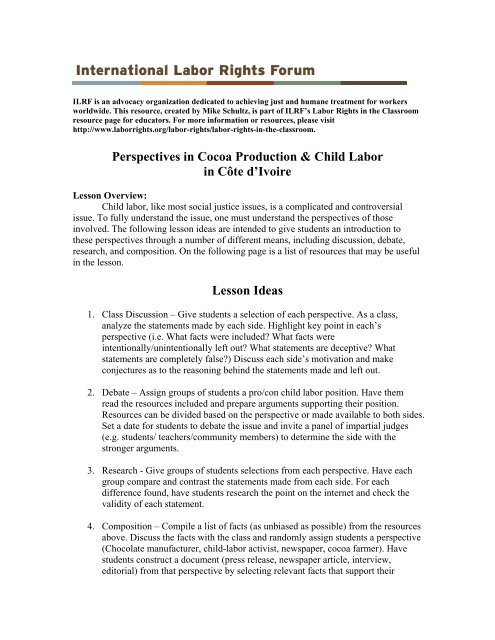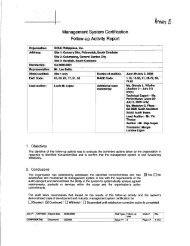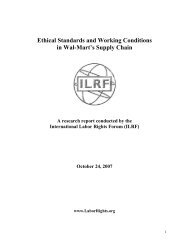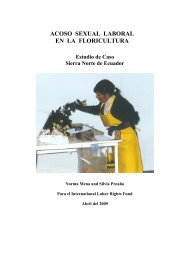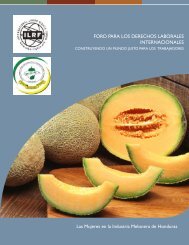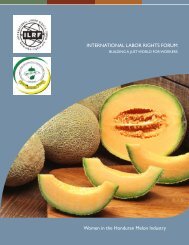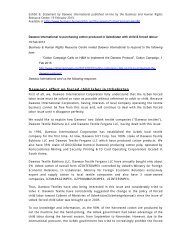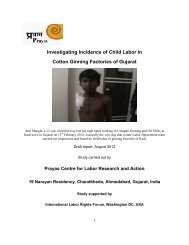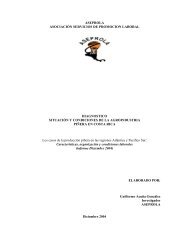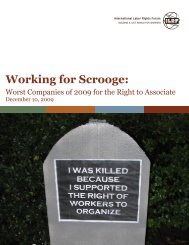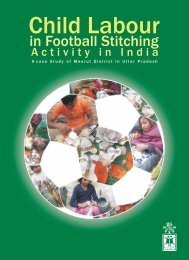Perspectives in Cocoa Production & Child Labor in Côte d'Ivoire ...
Perspectives in Cocoa Production & Child Labor in Côte d'Ivoire ...
Perspectives in Cocoa Production & Child Labor in Côte d'Ivoire ...
You also want an ePaper? Increase the reach of your titles
YUMPU automatically turns print PDFs into web optimized ePapers that Google loves.
ILRF is an advocacy organization dedicated to achiev<strong>in</strong>g just and humane treatment for workersworldwide. This resource, created by Mike Schultz, is part of ILRF’s <strong>Labor</strong> Rights <strong>in</strong> the Classroomresource page for educators. For more <strong>in</strong>formation or resources, please visithttp://www.laborrights.org/labor-rights/labor-rights-<strong>in</strong>-the-classroom.<strong>Perspectives</strong> <strong>in</strong> <strong>Cocoa</strong> <strong>Production</strong> & <strong>Child</strong> <strong>Labor</strong><strong>in</strong> Côte d’IvoireLesson Overview:<strong>Child</strong> labor, like most social justice issues, is a complicated and controversialissue. To fully understand the issue, one must understand the perspectives of those<strong>in</strong>volved. The follow<strong>in</strong>g lesson ideas are <strong>in</strong>tended to give students an <strong>in</strong>troduction tothese perspectives through a number of different means, <strong>in</strong>clud<strong>in</strong>g discussion, debate,research, and composition. On the follow<strong>in</strong>g page is a list of resources that may be useful<strong>in</strong> the lesson.Lesson Ideas1. Class Discussion – Give students a selection of each perspective. As a class,analyze the statements made by each side. Highlight key po<strong>in</strong>t <strong>in</strong> each’sperspective (i.e. What facts were <strong>in</strong>cluded? What facts were<strong>in</strong>tentionally/un<strong>in</strong>tentionally left out? What statements are deceptive? Whatstatements are completely false?) Discuss each side’s motivation and makeconjectures as to the reason<strong>in</strong>g beh<strong>in</strong>d the statements made and left out.2. Debate – Assign groups of students a pro/con child labor position. Have themread the resources <strong>in</strong>cluded and prepare arguments support<strong>in</strong>g their position.Resources can be divided based on the perspective or made available to both sides.Set a date for students to debate the issue and <strong>in</strong>vite a panel of impartial judges(e.g. students/ teachers/community members) to determ<strong>in</strong>e the side with thestronger arguments.3. Research - Give groups of students selections from each perspective. Have eachgroup compare and contrast the statements made from each side. For eachdifference found, have students research the po<strong>in</strong>t on the <strong>in</strong>ternet and check thevalidity of each statement.4. Composition – Compile a list of facts (as unbiased as possible) from the resourcesabove. Discuss the facts with the class and randomly assign students a perspective(Chocolate manufacturer, child-labor activist, newspaper, cocoa farmer). Havestudents construct a document (press release, newspaper article, <strong>in</strong>terview,editorial) from that perspective by select<strong>in</strong>g relevant facts that support their
position. Compare f<strong>in</strong>ished perspective papers with actual documents from thatperspective.Perspective ResourcesNewspaper / Press / General:• List<strong>in</strong>g of news & paper related to child labor <strong>in</strong> cocoa <strong>in</strong>dustryhttp://www.laborrights.org/press/<strong>in</strong>dex.html#cocoa• US Department of <strong>Labor</strong> on child labor <strong>in</strong> Cote D’Ivoirehttp://www.dol.gov/ILAB/media/reports/flt/cote-<strong>d'Ivoire</strong>-2002.htm#d19Corporate <strong>Perspectives</strong>:Press Releases, Statements, Websites• General: http://www.responsiblecocoa.org/• Nestle: http://www.nestle.com/Our_Responsibility/Responsibility.htm• Cargill: http://www.cargill.com/news/issues/cocoa<strong>in</strong>dustry.htmhttp://www.cargill.com/news/<strong>in</strong>dex.htm• ADM: http://www.admworld.com/pdf/ADMStatementEnglish.pdfhttp://www.admworld.com/naen/pressroom/Activist / Local Perspective:• NPR Kojo Nnamdi Show Interview: <strong>Cocoa</strong> and <strong>Child</strong> SlaveryAbstract: It's sweet, sugary...and scandalous? For many Americans, chocolate isconnected to <strong>in</strong>dulgence and pleasure. But human rights advocates say chocolate has adarker side. In West Africa scores of children are forced to harvest the cocoa beans thatmake our chocolate. A look at the issue of forced labor and the chocolate <strong>in</strong>dustry.GuestsLowell Satre, author of "Chocolate on Trial: Slavery, Politics, and the Ethics ofBus<strong>in</strong>ess"Jolene Smith, Executive Director, Free the SlavesNatacha Thys, Associate General Counsel, International <strong>Labor</strong> Rights FundEliot Engel, Congressman, U.S. House of Representatives (D-NY)L<strong>in</strong>k:http://www.wamu.org/programs/kn/05/08/08.phpDirect l<strong>in</strong>k to audio: http://www.wamu.org/audio/kn/05/08/k2050808-7927.asx• ILRF <strong>Child</strong> <strong>Labor</strong> and <strong>Cocoa</strong> CampaignFact sheets, list of press releases, and legal proceed<strong>in</strong>gshttp://www.laborrights.org/stop-child-labor/cocoa-campaign


